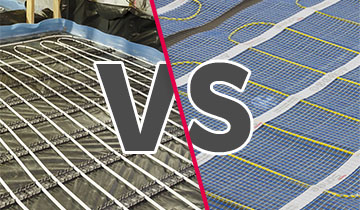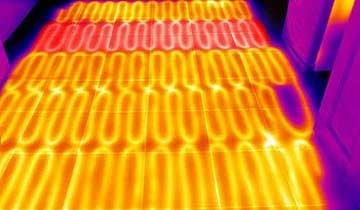11 min read
Water underfloor heating vs electric underfloor heating
In this heating blog article, we will be walking you through both water underfloor heating and electric underfloor heating to help you decide what...
5 min read
 Chris Hedges
:
Nov 30, 2021
Chris Hedges
:
Nov 30, 2021

It’s great that you are thinking about installing underfloor heating for your next project. You’ll receive all the benefits that come with underfloor heating like perfectly warm rooms, a reduction in energy waste and greater design freedom. Choosing between installing electric underfloor heating and wet underfloor heating is your next step on your journey to enjoying perfect radiant comfort.
With this in mind, we’ve created the ultimate guide to choosing between electric and wet underfloor heating.
Both systems produce radiant heat by heating the floor which means there is a much more even spread of heat compared with traditional central heating radiators. The floor area is larger than a traditional radiator and doesn’t need to be heated to a high temperature like radiators do which makes underfloor heating more energy efficient.
Electric underfloor heating
Electric heating cable is installed underneath the floor level, connected to the mains electricity supply and controlled with a thermostat. When turned on, the heating cable heats up which then warms the surface of the floor and generates radiant heat. You can buy the heating cable as a loose cable system, a heating and decoupling system (perfect for tiled floors) or pre-spaced as a mat which you simply roll out. When installing an electric underfloor heating system, you must get a Part P registered electrician to make the final connections to the mains.
Wet underfloor heating
Hydronic underfloor heating (wet) uses a series of pipes that are installed in the sub floor and warm water is fed through the pipework. A manifold is connected between the pipework and the heat source (usually a boiler or heat pump), which makes sure that the water is at the right temperature to heat up the floor above via the network of pipes. It’s important that you talk to the manufacturer of your boiler or heat pump to ensure that it is suitable for wet underfloor heating.
For an in-depth guide on how wet underfloor heating works, we would recommend visiting the website of a wet underfloor heating specialist such as WMS.
Electric underfloor heating
More commonly, electric underfloor heating is used in renovations or for smaller floor areas. This is because there is minimal impact on floor height and a faster installation time (depending on the size of the room). However, it is becoming more popular in new build projects due to its 100% efficiency and electric heating becoming more favourable than gas thanks to the drive to reduce carbon emissions in home heating.
On average an electric underfloor heating system will take 20-30 minutes to heat the room to the desired temperature as long as the system has been installed correctly and with insulation boards. Electric underfloor heating systems are available in a range of heating outputs. For example, 100W/m2, 150W/m2 and 200W/m2. The higher the wattage the faster the heat up time. So, for bathroom projects we would recommend an output of 150Wm2 and for conservatories we would suggest 200W/m2. The reason for the higher wattage for conservatories is because they are more prone to heat loss.
Cons: Uses electrical load that might be difficult to wire in, requires programming to be an efficient system (only on when you need it on).
Wet underfloor heating
New build projects are a wet underfloor heating system’s bread and butter. This is because when it comes to renovation projects there may not be sufficient floor height to accommodate the wet underfloor heating pipework without major disruption. Usually, wet underfloor heating is installed for use in rooms that are occupied for longer periods of time such as a kitchen or lounge. When it comes to heat up times and installed within a typical 65mm – 75mm sand and cement screed, it can take up to two hours to warm up to the desired temperature, and then stores the heat for longer due to the mass of screed that is heated up. There are many different types of screeds that can be used. Thinner flow screeds conduct heat to the floor finish better and because of this, heat up times become more in line with electric systems, around 30 to 40 minutes.
Cons: Longer time to heat up, sometimes requires upgrades to the boiler and new pipework which can be disruptive to the build.
Installation and material costs
When discussing costs, it is important to include material costs, installation costs, running costs and maintenance costs. It is also very dependent on the type of project.
According to Checkatrade the average quote to install 10m2 of electric underfloor heating is £800 and for wet underfloor heating it’s £1,200. The cost of installing differs again based on what type of project and this is illustrated in the table below.
Table: Cost of installing different types of UFH
|
Project Type |
Electric Underfloor Heating |
Wet Underfloor heating |
|---|---|---|
|
New Build |
£50 - £75 per m2 |
£120 - £135 per m2 |
|
Renovation |
£60 - £85 per m2 |
£135 - £185 per m2 |
To give you an idea of RRP cost for electric, a typical 10m2 Mesh system from ThermoSphere will cost £520 (Ex VAT) and a programmable thermostat a further £139 (this does not include accessories such as insulation board).
For wet underfloor heating the material costs would be in the region of £30m2 – £40m2 (excluding screed) for new build projects and for renovations it would be slightly more at £65m2 – £70m2. In order to get an accurate quote for wet underfloor heating, visit WMS.
Always check the quality of the system and for electric underfloor heating that would include the quality of the heating cable. Peer recommendation is always good to follow or online review sites like Trustpilot.
What about the running costs?
Currently, wet underfloor heating systems are cheaper to run than their electric counterparts. This is one of the reasons why wet underfloor heating is used for much larger floor areas such as entire floors in new build projects. By using good quality floor levelling, you can reduce the flow temperature further and save even more on the running cost.
With energy tariffs currently favouring gas, running the same heated area with electric underfloor heating will cost 3-4 times more. This is why electric underfloor heating is predominantly used for smaller areas of the average UK home. For a well-insulated bathroom (2.5m2), and depending on your tariff, you can expect to pay 14p for 3 hours per day. However, because it is only in use for around 150 days of the year, you can expect an annual running cost of £21. The running cost of electric underfloor heating can be reduced by taking advantage of existing solar PV and other renewable technologies. Check out the running cost calculator to view daily costs of running electric underfloor heating.
Maintenance costs of each underfloor heating system
Electric underfloor heating has no maintenance costs because there are no moving parts. Many systems come with lifetime warranties too for complete peace of mind.
Wet underfloor heating systems do not need maintenance directly. However, if you don’t already, ensure you have an annual boiler check because if that ends up breaking, you won’t be able to enjoy the comfort that a wet underfloor heating system provides.
Both electric and wet underfloor heating systems are both extremely energy efficient. In fact, both are much more efficient at heating a room when comparing with radiators.
The real difference between both underfloor heating systems is how the joule of energy is transported to the point of the system that generates heat. With a wet underfloor heating system, a boiler would be typically used to heat the water, then it is transported through a network of pipes to heat the room. Between 20-40% of the energy is lost as a result.
Because electric underfloor heating is 100% efficient at point of use and there’s no need to transport the energy as each joule is generated exactly where the heat is needed. That means that every pound spent on running it is converted to heat, right where it is needed.
It really comes down to what the project is and how large the heated area needs to be. Very large areas within new builds probably favour wet underfloor heating but everything else is perfect for electric. Just be mindful of running costs of each system and the maintenance costs to keep them at their peak performance.
If you’ve read this, and are looking for further advice specific to your project, we’d love to speak to you. Contact one of our experts.
Complete the short form and you'll receive a fast quote turnaround time along with the right product details for your property or project.
Need it even quicker? Call our HQ and one of the team will be happy to help on 0800 019 5899.

11 min read
In this heating blog article, we will be walking you through both water underfloor heating and electric underfloor heating to help you decide what...

6 min read
One of the most common fears of underfloor heating is the fear of it ‘going wrong’ or stopping working altogether. “Can electric underfloor heating...

5 min read
With the heating season just around the corner, and one of the busiest times of the year for any heating manufacturer, we thought it would be a good...